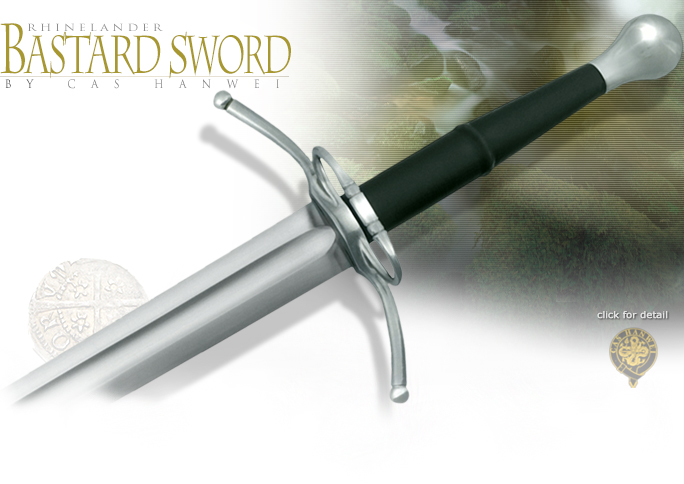RHINELANDER BASTARD SWORD  (SH2454) by CAS Hanwei (SH2454) by CAS Hanwei
Hanwei's Rhinelander Bastard sword, typical of late 15th century central European cut-and-thrust swords, is a handsome piece that will be appreciated by both collectors and cutting enthusiasts.
The ring-guard hilt and scent-stopper pommel balance a riveted-tang fullered blade that is forged in 5160 high-carbon steel and hardened to 54-HRc for an optimal combination of edge-holding and resilience. The blade is 35 3/4 inches of pure destruction, straight as an arrow and wickedly sharp. The cross-guard has a nice curved shape and features a ring on one side. The large bulbuss pommel is of steel and is peened. This sword is well balanced, feels light in hand, can be controlled with ease. A leather-wrapped scabbard is included and features metal Locket and Chape.

Read more on Functional Series Swords
|
|

• Overall: 45 1/4"
• Blade Length: 33 3/4"
• Blade: 5160 High Carbon Steel
• Edge: Sharp
• Width: 46.5 mm
• Thickness: 5.4 mm - 4 mm
• Point of Balance: 5 1/4"
• Grip Length: 6 3/4"
• Grip: Wood with leather wrap
• Weight: 3lb 4oz
Specs will vary slightly from piece to piece.
|
From around 1300 to 1500, in concert with improved armour, innovative sword designs evolved more and more rapidly. The main transition was the lengthening of the grip, allowing two-handed use, and a longer blade. By 1400, this type of sword, at the time called langes Schwert (longsword) or spadone, was common. The longsword became popular due to its extreme reach and its cutting and thrusting abilities. The term "hand-and-a-half sword" is relatively modern (from the late 19th century). This name was given because the balance of the sword made it usable in one hand, as well as two. During the first half of the 20th century, the term "bastard sword" was used regularly to refer to this type of sword. |
|

• Lowlander Sword SH2065 Hanwei

• Renaissance Wax
• Leather Sword Holder
• Magnet Sword Hanger

|